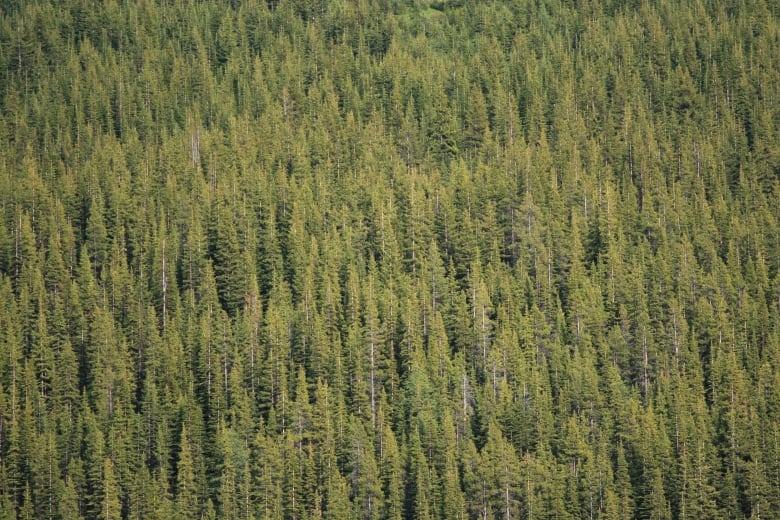The little-known, parasitic mistletoe stunting B.C. trees

Every so often, David Rusch climbs into his white pickup truck and rumbles up a gravel forest service road into the endless lodgepole pine forests surrounding Williams Lake, B.C.
He’s on the hunt for mistletoe, and not the festive kind.
Rusch is tracking local dwarf mistletoe because it’s a destructive, explosive parasite that races through the woods and sucks the life from trees at a blistering pace. Rusch, a veteran forest pathologist with province’s Ministry of Forests, can spot bristly clusters of infection sapping strength from a single, free-standing tree as the truck lurches past.
“You get the eye for it after a bit,” he said.
Managed properly, dwarf mistletoe is a normal, even healthy part of B.C.’s forest ecosystem, but improper management and natural disasters can clear the way for infestations that stunt fledgling trees and wreck up to 40 per cent of the volume — and profitability — of a forest.
It’s such a troublesome pest because failure to consider the mistletoe will doom young trees before they have a chance to grow and replenish the forest. It plays a role in how companies plan to regenerate an area after harvesting its lumber.
“Plants are good, but if they’re on wrong plants in your garden, then they’re weeds,” said Rusch, whose work as a forest pathologist centres on researching disease that affects the health of a forest.
Spreads ‘like a water cannon’
The dwarf mistletoe in B.C.’s forests isn’t the same leafy plant hung in doorframes as lead-in to a Christmas kiss; that version is European and doesn’t exist in Canada. The leafless North American species needs an evergreen host to survive. Trees with the disease are left swollen and distorted, their growth impaired.
The parasite is devilishly hard to get rid of because of the way it spreads.
When seeds mature inside dwarf mistletoe berries in the summer, the fruit explodes. Countless sticky seeds are sent flying in an arc at up to 85 km/h an hour, travelling up to 15 metres away from the host tree. The pellets rain down and latch on to shorter, defenceless young trees in the line of fire, and a new infection begins.
“It’s kind of crazy,” explained Rusch. “It’s like a water cannon.”
To prevent the spread of dwarf mistletoe in the province, harvesters have to ensure saplings are kept out of the seeds’ range.

Regeneration goals
Forestry has traditionally been B.C.’s most lucrative natural resource. Lumber companies taking trees from B.C.’s forests are obligated, under agreements with the province, to ensure an area is reforested in good health after a harvest, so the forest remains environmentally and economically sound.
Mistletoe threatens that objective because infected saplings fail to grow up properly, making them unfit for market.
So, for decades, harvesters have tried to avoid the problem by chopping down any dwarf mistletoe host trees as crews gather their lumber. Companies also leave a buffer between infected trees and replanting zones, to keep young trees out of the parasite’s reach.
“If you can eliminate that 15-metre radius spread around these overhead trees, then you can go a long way in reducing the impacts of mistletoe over time and slowing down the spread rate,” said Rusch, who helped write the province’s dwarf mistletoe management handbook in 2016.

Another forest pathologist, Harry Kope, said paper-like barriers wrapped around mistletoe are also used to intercept sticky seeds flying out of the berries.
“It’s like a cone of shame for dogs,” Kope explained.
Despite best efforts, mistletoe persists. Ungovernable wildfires and outbreaks of pine beetle devouring swaths of B.C.’s forests in recent years leave host trees behind, towering over young trees that will eventually sprout vulnerable below.
Parts of B.C.’s Cariboo-Chilcotin region, where Rusch works, are dealing with an excess of mistletoe. The issue is so widespread, B.C. Timber Sales is hiring contractors to trek into the woods in the new year and chop down diseased trees to give saplings a fair chance.
The pest exists in the other Canadian provinces, but Natural Resources Canada says B.C. is the most afflicted. The pest isn’t found in any of the territories.
Pathologists like Rusch and Kope monitor the parasite and track outbreak of disease. Both agree dwarf mistletoe has a rightful place in the ecosystem, as food for birds, insects and butterflies, but moderation is crucial.
“We’re like pediatricians. We’re making sure that the environment is correct and that these young plants get a plants to get up … and become good participating trees in the forest,” said Kope.
“Mistletoe has always been a problem … but we can try to avoid setting up big problems.”






